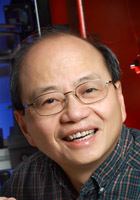Citizenship USA Name King-Wai Yau | ||
 | ||
Born October 27, 1948Guangzhou (Canton), China ( 1948-10-27 ) Academic advisors John G. Nicholls, Denis A. Baylor, Alan L. Hodgkin Known for mechanisms of sensory transduction in vision and olfaction Institution Johns Hopkins University, University of Texas Medical Branch | ||
King wai yau vision award winner 2008
King-Wai Yau (Chinese: 游景威; Pinyin: You Jing-Wei; born October 27, 1948) is a Chinese-born American neuroscientist and Professor of Neuroscience at Johns Hopkins University School of Medicine in Baltimore, Maryland.
Contents
- King wai yau vision award winner 2008
- Prof king wai yau university of sheffield
- Early Life Education Career
- Scientific Contributions
- Selected Honors Awards
- Highly Cited Papers
- References
Prof king wai yau university of sheffield
Early Life, Education & Career
Born in Guangzhou (formerly called Canton), Guangdong Province, China, he was the sixth of seven children. His family relocated to Hong Kong within months of his birth. His father, a businessman, died when Yau was only five years old.
He attended secondary school in Buddhist Wong Fung Ling College and St. Paul's Co-educational College in Hong Kong, before entering University of Hong Kong Faculty of Medicine to study medicine. Not wanting to be a physician, however, he departed for the United States in 1968 after only one year of medical study. He received an A.B. in physics from Princeton in 1971 and a Ph.D. in neurobiology from Harvard in 1975, completing his doctoral thesis under John G. Nicholls, a former student of Bernard Katz. He did postdoctoral work with Denis A. Baylor at Stanford University, then with Sir Alan L. Hodgkin at University of Cambridge, United Kingdom. Thereafter, he was on the faculty of University of Texas Medical Branch at Galveston (1981–86), rising to Professor of Physiology and Biophysics in 1985. In 1986, he became Professor of Neuroscience and Investigator of Howard Hughes Medical Institute (1986-2004) at Johns Hopkins University School of Medicine, where he has been since.
Scientific Contributions
He is known for discoveries on how light and odor are sensed in the eye and the nose, triggering neural signals to be transmitted to the brain. He has greatly elucidated the properties of the light responses and their underlying phototransduction mechanisms in retinal rods and cones, as well as in intrinsically-photosensitive retinal ganglion cells (which express the photopigment, melanopsin, to mediate mostly non-image vision such as pupillary light reflex and photoentrainment of the circadian rhythm). He has made similarly important discoveries on olfactory transduction in the receptor neurons of the nasal olfactory epithelium. His work impacts broadly on understanding G-protein signaling at a quantitative level. His investigations on the spontaneous activity of rod and cone pigments have provided a physicochemical explanation for why our vision does not extend into Infrared wavelengths.
He is a Member of the National Academy of Sciences and a Fellow of the American Academy of Arts and Sciences.
Selected Honors & Awards
• 1978, Alfred P. Sloan Foundation Fellow
• 1980, Visiting Fellow, Trinity College, Cambridge, United Kingdom
• 1980, Rank Prize in Optoelectronics, The Rank Prize Funds, United Kingdom
• 1993, Friedenwald Award, Association for Research in Vision and Ophthalmology (ARVO)
• 1994, Alcon Award in Vision Research, Alcon Research Institute
• 1995, Fellow, American Academy of Arts and Sciences
• 1996, Magnes Prize, Hebrew University of Jerusalem
• 2004, Teacher of the Year, Johns Hopkins University School of Medicine
• 2005, Alcon Award in Vision Research (second time), Alcon Research Institute
• 2006, Balazs Prize, International Society for Eye Research (ISER)
• 2008, António Champalimaud Vision Award, The Champalimaud Foundation, Portugal
• 2010, Member, National Academy of Sciences
• 2012, CNIB Chanchlani Global Vision Research Award, Canada
• 2013, Alexander Hollaender Award in Biophysics, National Academy of Sciences
Highly-Cited Papers
Articles with over 500 citations according to Google Scholar [1] as of May 6, 2017:
